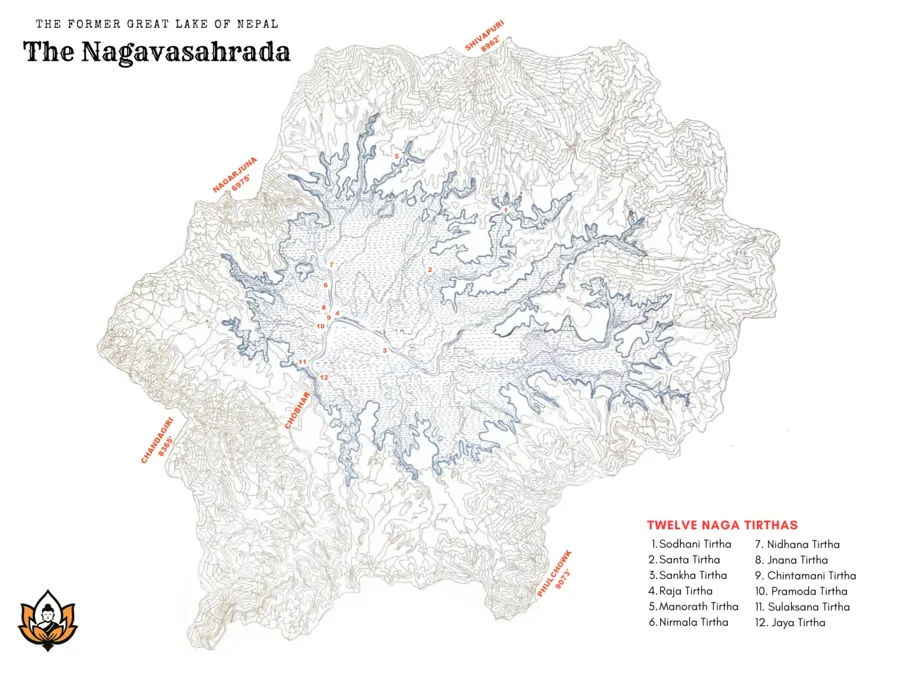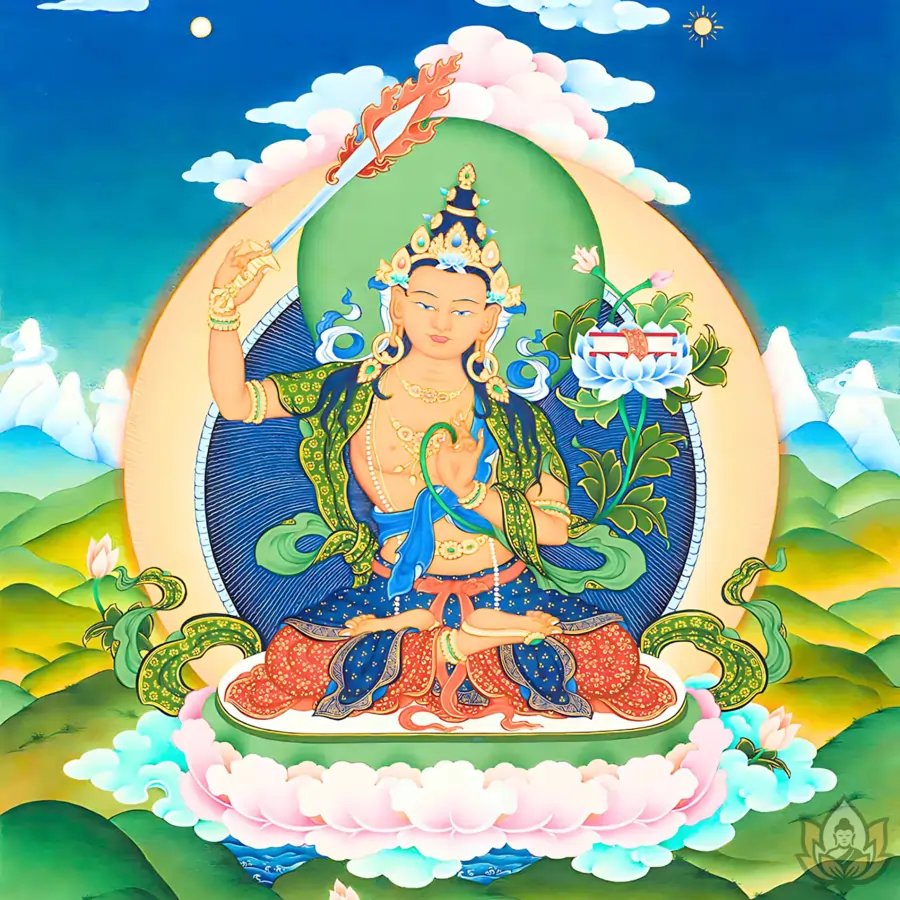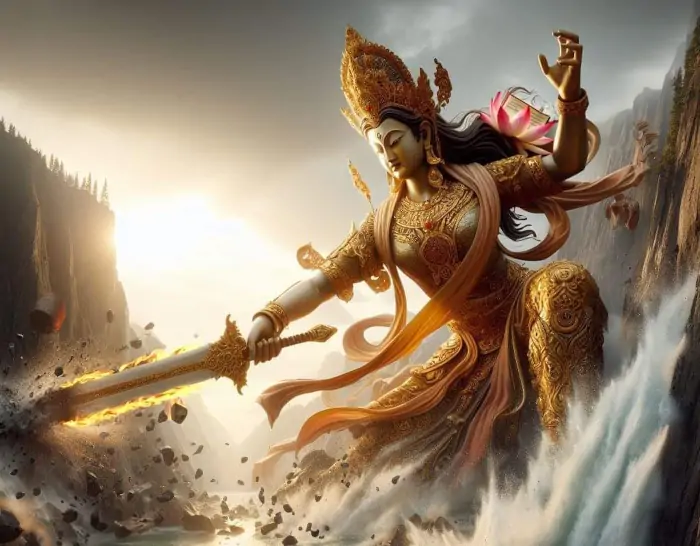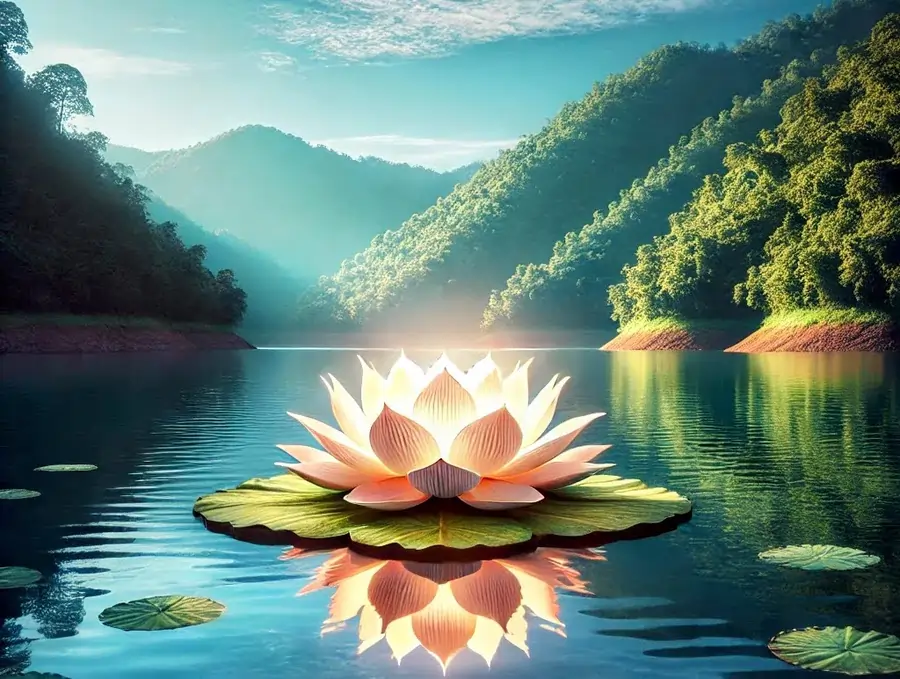Viswabhu Tathagata’s Prophecy
Sikhi Tathagata, the Second Buddha, dissolved into the Swayambhu Dharmadhatu, marking the end of his time. After a long gap in the lineage of Buddhas, Vishwabhu Tathagata, in Sanskrit विश्वभू तथागत, the Third Buddha, emerged to guide sentient beings. It was during a time when human lifespans reached 60,000 years, a period associated with the Treta Yuga – त्रेता युग (based on Swayambhu Hill referred as Vajrakuta Parvata). Among his disciples was Parvata Bodhisattva – पर्वत बोधिसत्त्व, who would later be reborn as Sakyamuni Buddha.
While Viswabhu Tathagata was teaching Buddha Dharma in his homeland of Anupana, his disciples requested him to visit Nagavasahrada and the sacred Swayambhu Dharmadhatu. Delighted by their request, Viswabhu Tathagata immediately set out with his disciples for Nagavasahrada (present day Kathmandu Valley).
Upon arriving, they paid homage from the peak located in the southeast of the valley, then called Phullochcha (now known as Pulchowk, the highest peak of the Valley Rim). At the summit, Viswabhu Tathagata entered deep meditation. His devotion was so powerful that it caused a significant earthquake. The quake was so intense that it reached the realm of the gods, disturbing them and causing all of creation to tremble.
One of his disciples named Gaganaganja (गगनगञ्जा) asked him to explain the meaning of the earthquake. Viswabhu Tathagata reassured them that it was not a bad omen. Instead, he revealed that he had received a vision about the future of Nepal. He predicted that a Bodhisattva would come to Nepal from MahaChin (present-day China) in the north. This Bodhisattva would drain the lake that filled the valley, transforming it into a habitable land for humans.
This prophecy not only explained the earthquake but also foretold a pivotal event in the history of the Nepal Valley, marking it as a place destined for spiritual and human flourishing.

The Vision of Manjushri
At the same time, in MahaChin (present-day China), Manjushri Bodhisattva – मन्जुश्री बोधिसत्त्व was meditating on Panchasirsa Parvata – पञ्चशिर्ष पर्वत (the Five-Peaked Mountain). Manjushri is also titled as the Son of the Buddha and is well-versed in all three qualities: wisdom, compassion, and power. He practiced Lokasandarsana Samadhi – लोकसंदर्शन समाधि, a contemplation to make the entire universe visible. During his meditation, Manjushri became aware of the Nepal Valley, the Nagavasahrada lake, and the holy light of Swayambhu Dharmadhatu. He also learned of Vishwabhu Tathagata’s meditation and predictions.
Determined to visit this sacred site, Manjushri made preparations for his journey. Accompanied by his two wives, Kesini (symbolizing wealth) and Upakesini (symbolizing learning) and other mahasattvas. He brought his sword Chandra Hasa – चन्द्रहास, symbolizing the power of mantra, and his sacred book Prajna (“Insight”), the central concept of Tantric Buddhism.

Birth of Swayambhu and Nepal Valley
Manjushri, accompanied by his two wives and the Mahasattvas, finally arrived at the place of Swayambhu, Nagavasahrada lake. Upon seeing the luminous Swayambhu Dharmadhatu, he offered his salutations, approached it, and performed Pradakshina. As they drew near the surrounding hills, his entourage gathered around him, filled with joy at the sight of Swayambhu. They spent the night there, and the next morning, with devotion and prosperity, Manjushri began chanting hymns in worship of Swayambhu Dharmadhatu.
He surveyed the lake’s shore and identified its lowest point, the southern Kacchapal Parvata (Kacchapal Parvata means Turtle Mountain), present-day known as Chobhar Gorge ( See in Map). Using his sword, Chandra Hasa (चन्द्रहास), he cut through the hill to drain the lake’s water. When he cut through the mountain, the rocks blocking the water were removed, allowing the pond’s water to flow out toward the Ganges and eventually the sea. From that day on, many rivers and ponds formed in the Nepal Valley.
With the lake drained, the Nepal Valley transformed into a fertile plain. Vajrakuta Parvata (Diamond Peak), now known as Swayambhu Hill, naturally emerged by itself, bearing the Swayambhu Dharmadhatu. The name Swayambhu is derived from the Sanskrit word स्वयम्भु, meaning “self-arisen,” “self-manifested,” or “self-born”.

Manjushri’s Promise: The Shrine of Karunamaya on Kacchapal Parvata
Kacchapal Parvata, deeply hurt and enraged, confronted Manjushri for his actions that had wounded the mountain. In response, Manjushri humbly apologized and explained that his intentions were guided by a noble purpose. He clarified that his goal was to benefit all living beings by transforming the valley into a habitable and fertile land. His actions were meant to create a space where life could thrive, bringing prosperity and spiritual harmony.
To pacify the mountain’s anger and honor its significance, Manjushri made a solemn promise. He vowed to establish a shrine dedicated to Karunamaya (Avalokitesvara, the All-Compassionate) at the summit of Kacchapal Parvata. This shrine, he assured, would become a sacred site of worship and homage, symbolizing compassion and reverence for all beings.
By making this promise, Manjushri not only sought to heal the relationship with Kacchapal Parvata but also ensured that the mountain would hold a revered place in the spiritual and cultural life of the valley. The act reflected his commitment to compassion and his vision of creating a harmonious balance between nature and humanity.
The Departure of Taksaka Nagaraja
Manjushri then returned to the Chobhar Gorge to inspect the water’s outflow. As he stood there, the serpent kings of the Nagavasahrada, realizing their dwelling had been destroyed, approached the gorge to leave. First came Taksaka Nagaraja with his family. Manjushri stopped him and pleaded, “Oh, Nagaraja, why are you leaving? Please remain here for the good fortune and fertility of Nepal Valley.”
Taksaka, however, angrily retorted, “How can I stay in a valley where the pure, clear water has been drained? You’ve destroyed my home. I cannot remain here; I will reside in the Great Ocean”. Seeing Taksaka’s resolve, Manjushri did not request again, and the serpent king departed.
Kulika Nagaraja’s Compromise
Next, Kulika Nagaraja approached with his family. Manjushri appealed to him, promising to create a peaceful residence for him and his kin. Kulika, considering that Manjushri would not remain in the valley forever, saw a future opportunity to block the gorge and refill the valley with water. Trusting Manjushri’s words, Kulika agreed and moved to Monorath Tirtha in Tokha Dobhan, near the Vishnumati River’s head.
Karkotaka Nagaraja’s Acceptance
Finally, Karkotaka Nagaraja, the King of Nagarajas, approached with his family. Manjushri addressed him respectfully, saying, “Oh King Nagaraja, this valley belongs to you; it is still your kingdom. All its wealth and treasures are yours. I have dried this lake to make the valley habitable and to serve Swayambhu Dharmadhatu. It is your duty as King to ensure the fertility of the land, the prosperity of its people, and the timely arrival of rains”.
Manjushri further promised to create a vast, deep lake and a jeweled palace as a residence for Karkotaka Nagaraja. Accepting this offer, Karkotaka chose to remain and settled in the lake now called Taudaha, meaning “Large Lake”, located about half a mile southwest of the Chobhar Gorge.
The Sacred Shrine of Goddess Khaganana Nairatyma Guheswari
Manjushri conducted a detailed survey of the Kathmandu Valley to identify its sacred and important sites. Among his key missions was to locate the root of the lotus planted by Vipaswi Tathagata. Upon finding the root, he discovered a water source emanating from it. The root of the Swayambhu Dharmadhatu Lotus is believed to be in what is now known as Guheswari (most probably present-day Purano Guheswari, Kathmandu).
Realizing that the underground water flowing from the root could refill the valley’s lake, Manjushri decided to take action to prevent this. He entered a deep meditation called Jalastambhana (जलस्तम्भन), aimed at stopping the underground water flow. During this meditation, he had a vision of Goddess Khaganana – खगानना, also known as Nairatyma Guheswari – नैरात्मा गुहेस्वारी. Inspired by the divine sight, Manjushri interrupted his meditation and prepared to worship the goddess.
To purify himself, Manjushri bathed and donned clean clothes. On a Sunday in the month of Mangshir, during the ninth day of the Krishna Paksha fortnight, he gathered with his followers to perform the worship of Goddess Khaganana Nairatmya (Guheswari). He remained awake all night, chanting sacred Dharani mantras and other hymns in devotion to the goddess.
The next morning, on the tenth day, Manjushri performed ablutions to cleanse his body, mind, and soul. He then offered sandalwood, water, and flowers to the Mother Goddess. Following this act of devotion, the lake’s water began to dry up.
From that day onward, Manjushri dedicated himself to the worship of Goddess Khaganana Nairatmya Guheswari, marking a significant spiritual and historical event in the valley’s history.
Manjushri’s Settlement and the Origin of Manjushri Hill
After draining the lake and creating the Nepal Valley, Manjushri, along with his two wives, Kesini and Upakesini, settled on the western side of the hill near Swayambhu Dharmadhatu. There, he devoted his life to the welfare of the world. Today, this western area of the Swayambhu hill is known as Manjushri Hill.
Swayambhu Purana – Table of Contents
« Chapter 3: Sikhi Tathagata: Worshipping Swayambhu
Chapter 5: Krakucchanda Tathagata: Origin of 12 Tirthas »

